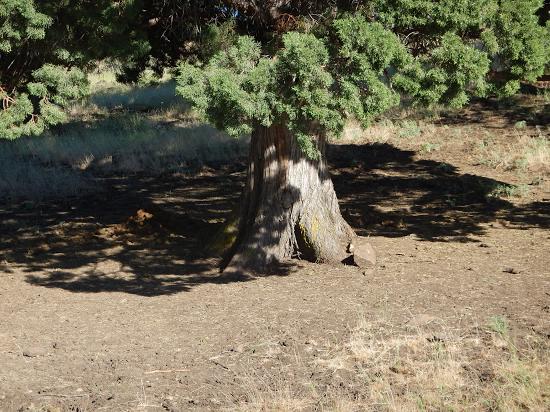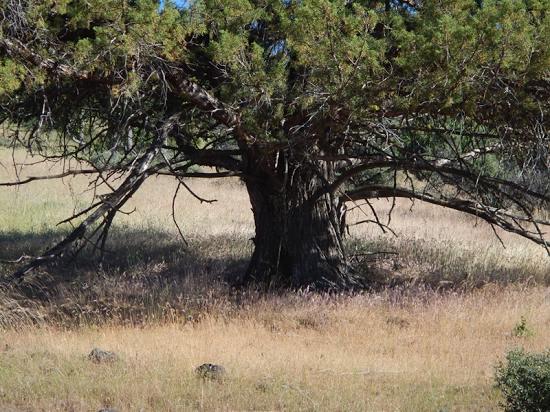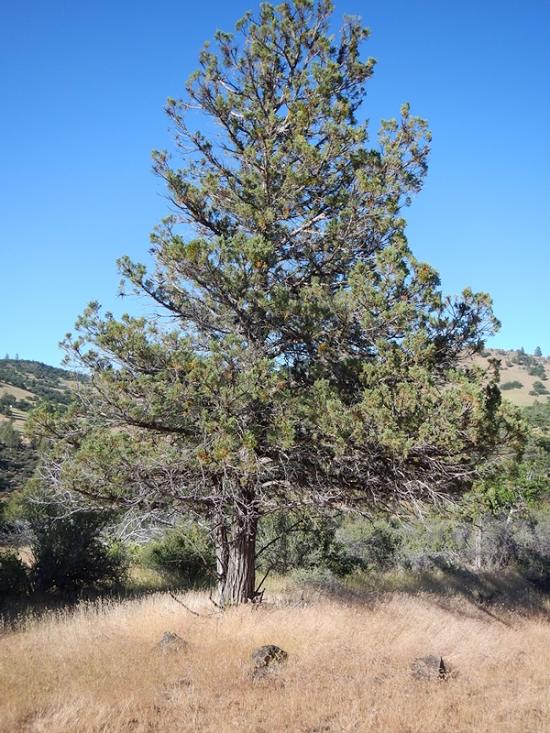Capt. William E. Simpson II – USMM Ret. contributed the following opinion article to Healthy Forests, Healthy Communities. The column offers a solution that Capt. Simpson says will save the Bureau of Land Management $58 million annually just on the corralled horses, and save the counties hundreds of millions in fire costs, and allow wild horses to be free.

When I see wild horses locked-out of nature in holding corrals, I see a huge resource being wasted by ignorance. It’s akin to putting an entire fire department in jail during fire season! If they’re not wanted on cattle-ranch lands that’s fine, but there are places where there is no competition issues with cattle, where these horses can serve a greater good. Here’s what I mean…
Like many other local and west-coast ranches, our ranch and its lands are located in rough mountainous terrain. And like many other areas with varied mountain-valley terrains, we have a lot of grass (fuel for fires) and underbrush on normal years since there are no-longer large herds of deer grazing it off or cattle in the area. Cattle and sheep ranchers moved-out of the local areas long ago due to excessive numbers of predators and difficult terrain for managing domestic livestock.
It’s worth considering that In 1960 we had about 2-million deer grazing in CA, whereas today we have less than 375,000 deer in the entire State. And that there is a direct mathematical correlation between the loss of large herbivores and the increase in catastrophic wildfires.
Now the stage has been set, and this year the fuel on the ground due to an exceptionally wet winter and spring, is excessive, with dense grass and brush that represents a very serious fire hazard to area homes, ranches, pastures and forests.
It’s just amazing to me that most of the people running the forests and counties haven’t made this realization yet and taken appropriate actions. And there is an appropriate cost-effective action and solution available, that is unless they like seeing these wildfires devastate our landscape and ecosystems at the great expense of taxpayers!
The relatively very few horses we have up here in our area truly help with excess fuel abatement, but in order to have a real solution, we’d need another 5,000 deer and 500 horses in the local area just to mitigate some of the wildfire risk in and around our 950-acre ranch, which is surrounded by tens of thousands of acres of both private and some forestry lands, along with the Cascade-Siskiyou National Monument to the north. The 60 horses that are around the area can’t begin to control all the grass on our lands let alone neighboring lands, even with all the other herbivores combined, so we worry a lot when the summer lightening storms show up like earlier this week.
Our local horses eat the young poison oak, scrub oak, tips of buck brush and star thistle (before the spikes come on) and the grasses as they browse (they move relatively fast as they graze, compared to cows).
Growing-up on a ranch made me a very practical person, so using a natural resource to deal with a very serious problem just seems logical. And in the scheme of things, I don’t see how cattle-industry politics on wild horses is solving or paying-for our fire situation and the huge annual costs incurred in money, property and lives that are paid by rural cities and counties.
Given the unabated fire hazard facing our County and hundreds of other counties annually, and the huge direct and tertiary costs for those fires in lives, property and money, I think it would wise to immediately begin the re-introduction of wild horses into areas that are not used by cattle and which have inadequate large herbivore (deer-elk) herds to help mitigate the insane fire hazard by reducing extensive grass and brush cover. Wild horses are experts at grazing in difficult terrain and may be obtained without cost from the BLM’s holding corrals outside of Reno, NV, Palomino, Susanville and Litchfield CA, as well as Burns OR. There are other BLM centers where horses are being held in southern CA as well as in other states, including UTAH, Colorado, Wyoming and elsewhere. These many BLM wild burro and horse holding facilities are conveniently located near many of the worst wildfire areas in America, including AZ, CA, NV, CO, WY and OR.
From what I have observed (prodigious amounts of vegetative fuels from a wet winter and spring), we’re in for a potentially devastating fire season this year on the West Coast.
If the County wanted (or at least some private property owners), it could adopt some of the horses that are available (free). It seems silly not to take advantage of what horses do so very well naturally, instead of spending millions of taxpayer’s dollars preparing-for and fighting catastrophic wildfires, and suffering the related losses of property and lives.
Obviously, some ranchers and land owners who are opposed to wild horses could opt out, and instead use cattle, bison or sheep, but those herbivores cost money and require much more management and oversight than wild horses, which evolved in the area and are a native species. The thing about wild horses is that they fare-well on their own and horses aren’t devastated as badly as sheep and cattle by lions, wolves and coyotes.
However, with that said, I should note that our small herd of local horses has nevertheless suffered a net drop in population due to the death of older horses and predation of younger horses. So in just the past 4 years, we have to our knowledge a 10-animal net loss; we’ve named/photographed them, so we keep fairly close tabs on the local herd as we study their benefits to the local ecosystem.
Something that is often overlooked, even by wild horse advocates is that wild and feral horses are also highly beneficial to trees and forests! They graze-off the grass and brush (fuels) under the trees. And as they do, they break-off and crush dry fuel branches into small pieces, which when come into contact with the soil, break-down into humus. This is something that other critters cannot do since it requires a large herbivore. Left unabated, these low-hanging dry branches and fuels under the trees add tremendous heat under the trees during fires, which can damage and burn even heat resistant trees that have heavy or specialized bark.
Horses also add humus to the ground via their manure. This is done when the horses shelter under the trees and in other areas they frequent. I have a dozen photos that exhibit these important points. The results are envious, even to experienced park-maintenance personnel.




A juniper tree (seen above) that is frequented by horses stands-out and is visibly more vibrant and more fire resistant (note health of its canopy) than nearby junipers that are not frequented with sparse dry canopies.
We have dozens of trees on our lands that are frequently used by the local horses in both summer and winter and you can point them out from a 1/4 mile away due to their healthy robust canopies. Wild horses have a symbiotic mutualism with all trees and grasslands, and they create park-like grooming under trees they use for scratching (breaks-off and clears dead branches close to the ground) and shelter from weather and sun.
As a land-owner worried about fires and losing trees, the horses provide a service with genuine value that is most welcomed and is very cost effective!
There is just too much false and misleading information about wild-feral horses floating around these days, much of which disparages the temperament of wild horses as one of many obtuse excuses to damn them to BLM holding pens, or worse yet, to a painful and hellish slaughter. And for Christians who actually follow God’s laws and the Bible, horses or burros must not be eaten according to Leviticus-11 and Deuteronomy-14.
Contrary to rumor, the vast majority of wild and feral horses don’t have a malicious bone in their bodies. It’s the abuse at the hands of people that gives horses a bad attitude and when any animal loses its trust of humans, of course it becomes defensive and people can and do get hurt.
The foregoing claim about wild-feral horses is best exemplified by an encounter my wife and I had with a wild-feral horse we met for the first-time on a mountain top behind our ranch. This home-video provides some genuine insight into my claim.
Today, that same horse has grown into sweet-mannered adult with a mutualism to the forests and grasslands where he lives along with the other families of horses and the few deer that remain in an area that is racked with predators as a result of mismanagement by Fish & Game. It’s also interesting to see that the few remaining local deer use the horses as cover from predators and will graze close-by to the horses for added protection and as a warning system.
County planners should take advantage of this cost-effective fire brigade, which is not unionized, doesn’t require health benefits, needs no breaks and never sues the county for HR issues. How can you beat that?
The BLM holding corrals in Litchfield, CA and at all the other holding facilities throughout the the west currently have over 40,000 horses available for fire mitigation duty… let’s put them to work doing what they do best!
William Simpson is the author of Dark Stallions – Legend of the Centaurians, proceeds from which go towards supporting wild and domestic horse rescue and sanctuary.
Capt. William E. Simpson II is a U.S. Merchant Marine Officer with decades of boating and expedition sailing experience, having logged more than 150,000 miles at sea. Simpson has successfully survived long-term ‘off the grid’ at sea and at remote uninhabited desert islands with his family for years at a time. He holds a U.S.C.G. 500-ton captain’s license for commercial-inspected passenger vessels and he is also a commercial airplane and helicopter pilot.
Simpson spent his formative years growing up on the family’s working ranch in the mountains of Southern Oregon, where horses were an integral part of the daily life. William left the family ranch to attend college, which turned out to be a stepping stone into a bizarre lifestyle that led him around the world on an entrepreneurial quest. An adventurer at heart, Simpson and his best friend and wife Laura, spent many years at sea during two sailing expeditions (1991-1994 and 2008-2011) where they experienced some of the many wonders and mysteries of nature. Since retiring, Bill and Laura have changed lifestyles and are once again engaged in a new adventure; living an off-grid lifestyle in the remote wilderness of the Siskiyou Mountains, where they enjoy coexisting with herds of wild horses, along with a myriad of other wild animals. The staggering beauty of the local mountains and valleys is awe inspiring and has influenced Bill to frequently write on subjects related to wild horses as well as wild and domestic horse advocacy, rescue and sanctuary.



